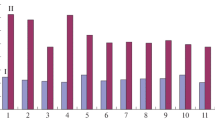Summary
The role of various iron chelators on the multiplication of mouse hybridoma cells in an albumin-free, transferrin-deficient defined medium was investigated. Fe(III)-dihydroxyethylglycine, Fe(III)-glycylglycine, Fe(III)-ethylenediamine-N,N′-dipropionic acid, or Fe(III)-iminodiacetic acid supported the excellent growth of the cells. In addition, the growth of the iron-starved cells, which had been preincubated in a protein-, iron- and chelator-free defined medium, restored rapidly when the medium was supplemented with holotransfeerrin, ferric iron, and chelator compared to that when supplemented with holotransferin, but without iron and chelator. The results suggest that such chelators modulate a progression of transferrn cycle in the presence of transferin and ferric iron. An alternative explantation is that there is a decrease in generation of iron-catalyzed free radicals.
Similar content being viewed by others
References
Aisen, P.; Listowsky, I. Iron transport and storage proteins. Ann. Rev. Biochem. 49: 357–393; 1980.
Barnes, D.; Sato, G. Serum-free cell cultures; a unifying approach. Cell 22:649–655; 1980.
Basset, P.; Quesneau, Y.; Zwiller, J. Iron-induced L1210 cells growth: evidence of a transferrin-independent iron transport. Cancer Res. 46:1644–1647; 1986.
Bishop, C. T.; Mirza, Z.; Crapo, J. D., et al. Free radical damage to cultured porcine aortic endothelial cells and lung fibroblasts: modulation by culture conditions. In Vitro 21:229–236; 1985.
Bowman, C. M.; Berger, E. M.; Butler, E. N., et al. HEPES may stimulate cultured endothelial cells to make growth-retarding oxygen metabolites. In Vitro 21:140–142; 1985.
Bridges, K. R.; Cudkowicz, A. Effect of iron chelators on the transferrin receptors in K562 cells. J. Biol. Chem. 259:12970–12977; 1984.
Bullen, J. J. The significance of iron in infection. Rev. Infect. Dis. 3:1127–1138; 1981.
Friedberg, F. Albumin as the major metal transport agent in blood. FEBS Lett. 59:140–141; 1975.
Good, N. E.; Winget, G. D.; Winter, W., et al. Hydrogen ion buffers for biological research. Biochemistry 5:467–477; 1966.
Graf, E.; Mahoney, J. R.; Bryant, R. G., et al. Iron catalyzed hydroxyl radical formation: sringent requirement for free iron coordination site. J. Biol. Chem. 259:3120–3124; 1984.
Gutteridge, J. M. C.; Paterson, S. K.; Segal, A. W., et al. Inhibition of lipid peroxidation by the iron-binding protein lactoferrin. Biochem. J. 199:259–261; 1981.
Kan, M.; Yamane, I. In vitro proliferation and lifespan of human diploid fibroblasts in serum-free BSA-containing medium. J. Cell Physiol. 111: 155–162; 1982.
Kaplan, S. S.; Quie, P. G.; Basford, R. E. Effect of iron on leukocyte function: nactivation of H2O2 by iron. Infect. Immun. 12:303–308; 1975.
Karin, M.; Mintz, B. Receptor-mediated endocytosis of transferrn in developmentally totipotent mouse teratocarcinoma stem cells. J. Biol. Chem. 256:3245–3252; 1981.
Kay, G. F.; Ellem, K. A. O. Nonhaem complexes of FeIII stimulate cell attachment and growth by a mechanism different from that of serum, 2-oxocarboxylates, and haemproteins. J. Cell. Physiol. 126:275–284; 1986.
Mather, J.; Wu, R.; Sato, G. The role of hormones in the growth and regulation of cells in a serum-free medium. In: Waymouth, C.; Ham, R. G.; Chapple, P. J., eds. The growth requirements of vertebrate cells in vitro. England: Cambridge University Press; 1981:244–251.
Rasmussen, L.; Toftlund, H. Phosphate compounds as iron chelators in animal cell cultures. In Vitro 22:177–179; 1986.
Rudland, R. S.; Durbin, H.; Clingan, D., et al. Iron salts and transferrin are specifically required for cell division of cultured 3T6 cells. Biochem. Biophys. Res. Commun. 75:556–562; 1977.
Shipman, C. Evaluation of 4-(2-hydroxyethyl)-1-piperazne-ethanesulfonic acid (HEPES) as a tissue culture buffer. Proc. Soc. Exp. Biol. Med. 130:305–310; 1969.
Spiro, T. G.; Allerton, S. E.; Renner, J., et al. The hydrolytic polymerization of iron(III). J. Am. Chem. Soc. 88:2721–2726; 1966.
Van Asbeck, B. S.; Marx, J. J. M.; Struyvenberg, A., et al. Effect of iron(III) in the presence of various ligands on the phagocytic and metabolic activity of human polymorphonuclear leukocytes. J. Immunol. 132: 851–856; 1984.
Van Renswoude, J.; Bridges, K. R.; Harford, J. B., et al. Receptor-mediated endocytosis of transferrin and the uptake of Fe in K562 cells: identification of a nonlysosomal acidic compartment. Proc. Natl. Acad. Sci. USA 79:6186–6190; 1982.
Ward, C. G.; Hammond, J. S.; Bullen, J. J. Effect of iron compounds on antibacterial function of human polymorphs and plasma. Infect. Immun. 51:723–730; 1986.
Williams, A.; Pugh, A.; Hoy, T. G., et al. Screening for iron chelating drugs. In: Saltman, P.; Hegenauer, J., eds. The biochemistry and physiology of iron. Amsterdam: Elsevier North Holland, Inc.; 1982:199–204.
Yabe, N.; Matsuya, Y.; Yamane, I., et al. Enhanced formation of mouse hybridomas without HAT treatment in a serum-free medium. In Vitro 22: 363–368; 1996.
Yamane, I.; Murakami, O.; Kato, M. Role of bovine serum albumin in a serum-free suspension cell culture medium. Proc. Soc. Exp. Biol. Med. 149: 439–442; 1975.
Author information
Authors and Affiliations
Rights and permissions
About this article
Cite this article
Yabe, N., Kato, M., Matsuya, Y. et al. Role of iron chelators in growth-promoting effect on mouse hybridoma cells in a chemically defined medium. In Vitro Cell Dev Biol 23, 815–820 (1987). https://doi.org/10.1007/BF02620959
Received:
Accepted:
Issue Date:
DOI: https://doi.org/10.1007/BF02620959




